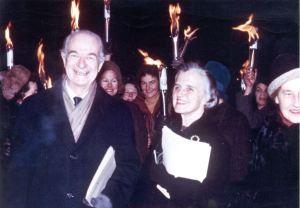
Torchlight procession in Oslo, December 1963.
After the Nobel Peace Prize ceremonies had passed, Linus and Ava Helen Pauling remained in Scandinavia into the New Year, visiting friends and making several public appearances in the region. In the wake of his prize, Pauling continued to speak on the importance of peaceful international relations and also addressed scientific audiences. Often, the two would overlap.
For the rest of the first week, the Paulings remained in Oslo where the whole family was able to spend some time together and mingle informally with others. On Friday, December 13th, the Paulings visited the Munch Museum, which had just opened to mark the hundredth anniversary of the birth of Norwegian painter Edvard Munch. Afterwards, they attended a luncheon hosted by the Norwegian Chemical Society. The weekend continued with informal meetings and a party at the home of Otto Bastiansen, who had helped the Paulings to plan their activities while in Scandinavia.
The following Monday, the Paulings flew north to Trondheim where Linus gave a Normann Lecture, part of a popular series on philosophy and science sponsored by the estate of Evard Normann, a local fishmonger. Pauling’s talk, “Humanism and Peace,” continued in the vein of his Nobel Lecture by addressing the need for humanity to decide between peace reached through reason, versus annihilation brought on by war. Pauling emphasized that people were no longer separated into small groups where communication was easier. “Now we are all bound together,” he said. “One organism. Will it survive or become extinct?”
Pauling then referred to Aristotle’s assertion that nations were inherently immoral, suggesting that “Now they will become moral.” The next day, Pauling kept up his slate of public appearances by meeting with local high school students and by giving a lecture to the Trondheim section of the Norwegian Chemical Society on the role of molecular diseases in evolution.
The Paulings spent the rest of the week in Sweden. Their first stop took them to Stockholm, where they were immediately met by a collection of prominent Swedish scientists and politicians. Later, Pauling addressed the press before attending a reception hosted by the local chapter of the Women’s International League for Peace and Freedom.
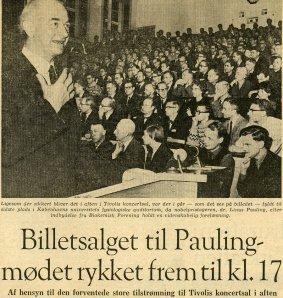
Published in Land og Folk, January 3, 1964.
The next morning, Linus gave another lecture on molecular disease and its relation to evolution, this time to the Swedish Royal Institute of Technology. In the afternoon, the Paulings visited the newly opened Wenner-Gren Center, which Hugo Theorell, head of the Nobel Medical Institute’s Biochemistry Department, described to Linus as representing “one of the many ways which have to be tried in order to improve mutual understanding and friendship between different people and races.” Devoted to scientific collaboration across borders and staffed by researchers from thirty countries, Wenner-Gren struck Pauling as a good example of how science could foster peaceful international cooperation.
That evening, local peace groups held a torch light procession in honor of Pauling. The march ended in front of the Storkyrkan, the oldest church in Stockholm, where Pauling then gave a speech on peace. The talk was similar to the Trondheim address, referring again to Aristotle’s notion that nations are inherently immoral, since, as Pauling quoted, “It is considered proper for a strong nation to attack a weak one, if she can thereby benefit herself, irrespective of what the principles of morality have to say about this action.”
Pauling also condemned the United States’ rejection of the 1957 Rapacki Plan, which would have established a nuclear free zone in central Europe. “Up to that time,” Pauling said, “everything had been simple. Everything could be blamed on the Russians.” Afterward however, Western intellectuals began to lose faith that the “free world” sought “peace, democracy, and a better future.”
From Stockholm, the Paulings went southwest to Gothenburg and then south again to Lund, stopping at both cities’ universities to speak on his own path to becoming a peace activist. From there the Paulings returned to Oslo and enjoyed a more relaxed schedule over the holidays.
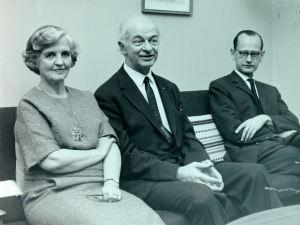
Ava Helen and Linus Pauling with Martin Ottesen, Copenhagen, January 1964.
Before heading back to the United States, the Paulings spent one day in Copenhagen, where Linus would give one final talk on peace. According to a letter to Pauling from Gerda Ottesen – wife of Martin Ottesen, the director of the Carlsberg Laboratory – Pauling’s time there led to the nascent formation of a “Pauling Group” that endeavored to translate Pauling’s speeches and writings on peace into Danish. Ottesen also informed Pauling that he had become of interest to a newly formed political party which had emerged out of disputes from within the Danish socialist party. His mark clearly made in Scandinavia, Pauling headed back to the States.
The Paulings arrived in New York City on Saturday, January 4th and kept a low profile during their first few days on home soil. On Wednesday they flew to Washington, D.C. for a press conference – their first public appearance in the United States since Pauling had been awarded the Nobel Prize. The Women’s National Press Club hosted the press conference, according to president Elsie Carper, so that Pauling could talk about the responsibility that scientists have in a democratic society and to “promote better understanding” of science in “world affairs.”
Despite the event’s stated intention, what ended up in print contained little in the way of science. As with mainstream reporting from the Nobel ceremony, writing on the press conference focused mostly on Pauling’s previous statements about the need for China to be involved in disarmament negotiations and his much published suggestion that “there will never again be a world war – or any war in which nuclear weapons are used – or any great war.”
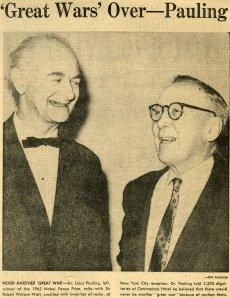
Published in the Pasadena Star-News, January 9, 1964.
Other aspects of the press conference dug more into Pauling’s political background. During the question and answer portion, one reporter asked Pauling if he would ever run for office. Pauling said he would rather work on his science and for peace independently, and that he was too “selfish” to run for office. He spoke as well of growing up in a Republican family and noted that he did not become a Democrat until 1932, when so many others also changed their minds on account of the Great Depression. Pauling added, “I have been one ever since.”
The media event concluded, the Paulings hurried back to New York City that afternoon so that they could attend a tribute held at the Hotel Commodore. Sponsors of the event included several scientists from around the world, as well as Bertrand Russell, Walter Cronkite, Senator George McGovern, and Arthur Miller. The gala was also attended by United Nations Secretary General, U Thant.
Pauling gave a short speech during the proceedings but was only one among many who spoke – Ava Helen, Dagmar Wilson of Women Strike for Peace, and historian Henry Steele Commager also enjoyed their moment at the podium. For his part, Pauling gave a very clear and accessible account of how many nuclear weapons were then in existence, stating,
If there were to take place tomorrow a 6-magaton war, equivalent to the Second World War in the power of explosives used, and another such war the following day, and so on, day after day, for 146 years, the present stockpile would then be exhausted.
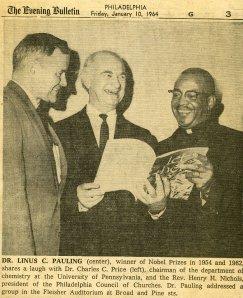
Published in the Philadelphia Evening Bulletin, January 10, 1964.
The Paulings rested the next day and then took to the skies once more, this time destined for Philadelphia where they made two more public appearances. On Thursday, January 9th, local peace groups, including Women Strike for Peace and the Society for Social Responsibility in Science, sponsored another tribute to Pauling. In addition to hearing Pauling and others speak, those attending were also availed of the opportunity to sign pre-printed postcards addressed to President Lyndon Johnson which applauded his call for a “Peace Offensive” while also continuing to urge him to negotiate for complete disarmament. The following night, the local Women Strike for Peace chapter held a cocktail party in honor of the Paulings.
The Paulings headed back to New York City on Saturday where they would attend one more reception in their honor, this time hosted by the Women’s International League for Peace and Freedom. On Wednesday they, at long last, flew back to California, thus concluding their five and a half weeks of travelling, lecturing, and celebrating in connection with Linus Pauling’s Nobel Peace Prize. Once home, Pauling did not rest for long: within days he was in public again giving speeches outlining what he saw as the “Next Steps” to reach disarmament and peace in the world.
